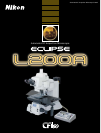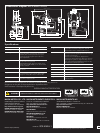
The next generation in automated
IC inspection microscopy
The Eclipse L200A has scored major
advances in the standardization of
inspection and safeguards against
contamination. In a new design that
combines motorized control with
automated operation, observation
conditions can be programmed for
each individual objective or for each
substrate to be inspected. Focus position,
objective magnification, illumination control
and other microscope methods are fully
programmable and can be recalled instantly.
This eliminates deviation in inspection
results that might occur due to different
settings made by multiple users.
To minimize the chance of
contamination, the L200A's aperture
control and other major operations
are now motorized, enabling remote
control for use on unattended IC
production lines. Like other Eclipse-
series microscopes from Nikon, the
L200A features industry-acclaimed CFI60
infinity optics.
Include an ergonomic design for comfortable
viewing, a rigid, vibration resistant
construction, and you have a microscope
unsurpassed to meet the stringent
requirements of the latest semiconductor fabs.
The L200A is the next step upward in
automated IC inspection microscopy.
Standardized, contamination-free inspections
Cursor keys
LCD screen
DIC adjustment
knob*
Aperture keys
Darkfield key
Brightfield key
Option keys
Objective
selection keys
Enter key
Menu key
Focus dial
Focus Coarse/Fine
changeover key
AF-MF changeover key*
Focus fine adjustment knob*
(When AF is ON)
Lamp intensity Auto/
Manual changeover key
Lamp intensity control knob
Motorized, remote control minimizes
the chance of contamination, while
enhancing productivity
Frequently used operations such as aperture control, focusing, brightfield-
darkfield changeover, nosepiece rotation, lamp intensity control, and DIC
setting (option) are all motorized and can be controlled by the remote
controller or a PC. In addition, there is virtually no operation that requires
manual adjustment above the sample, therefore preventing particle
contamination introduced from the operator.
Free from deviations in
inspection results, due to
human errors and differences in
microscope settings
Optimum observation conditions including focus position,
aperture, light intensity, as well as DIC prism and polarizer
position can be preset objective-by-objective and recalled
simply by selecting the objective. This eliminates the need
to configure these settings each time the microscope is
used, providing standardized observation regardless of
who operates the microscope.
3
*Active when the respective optional module is attached.
Remote Controller







